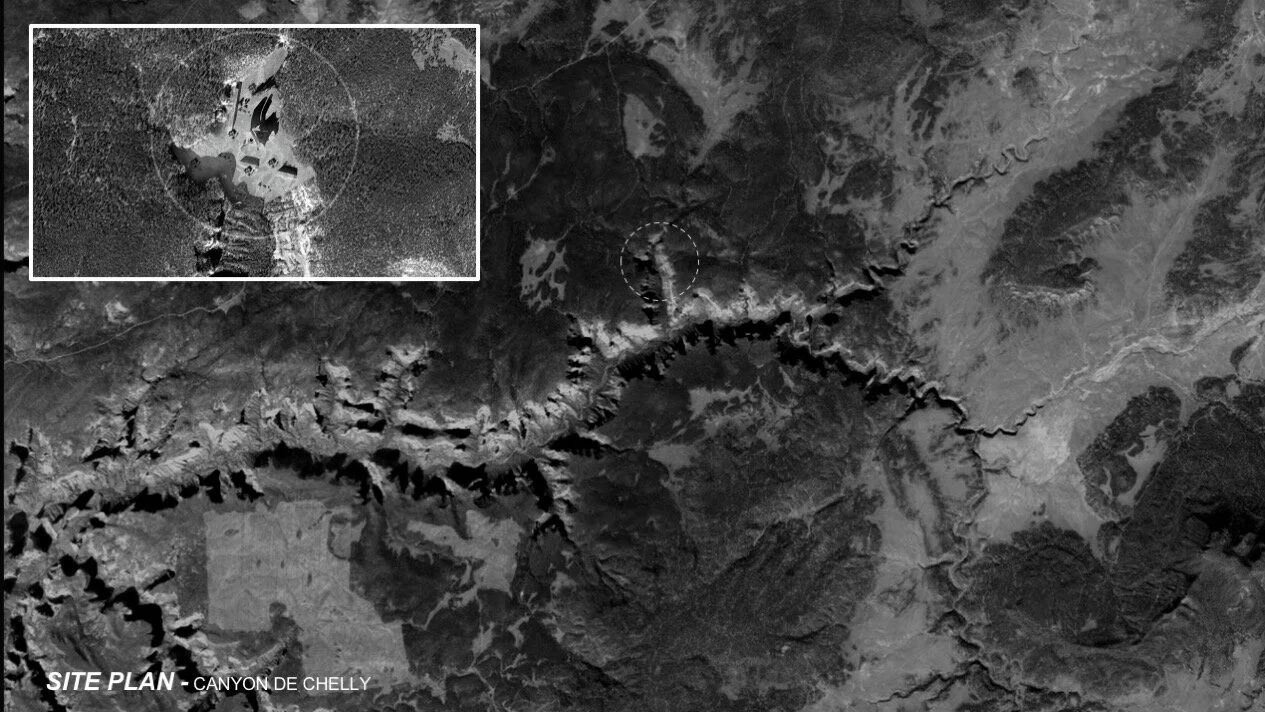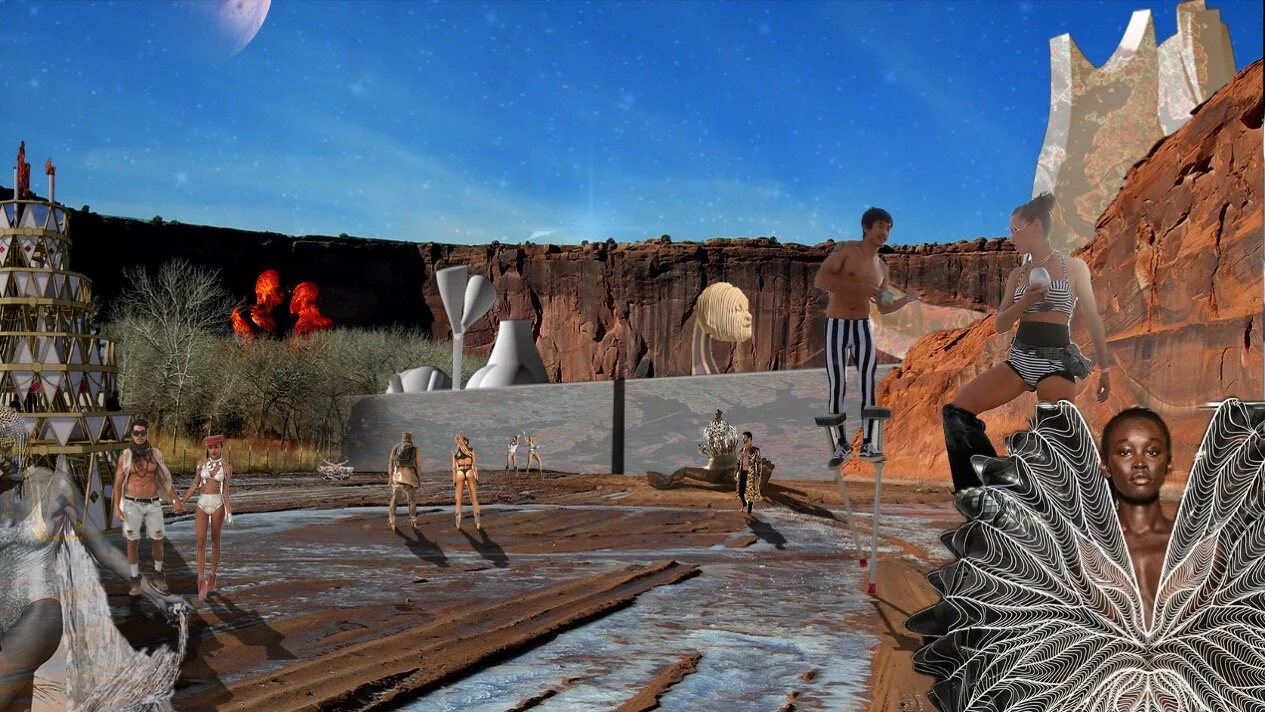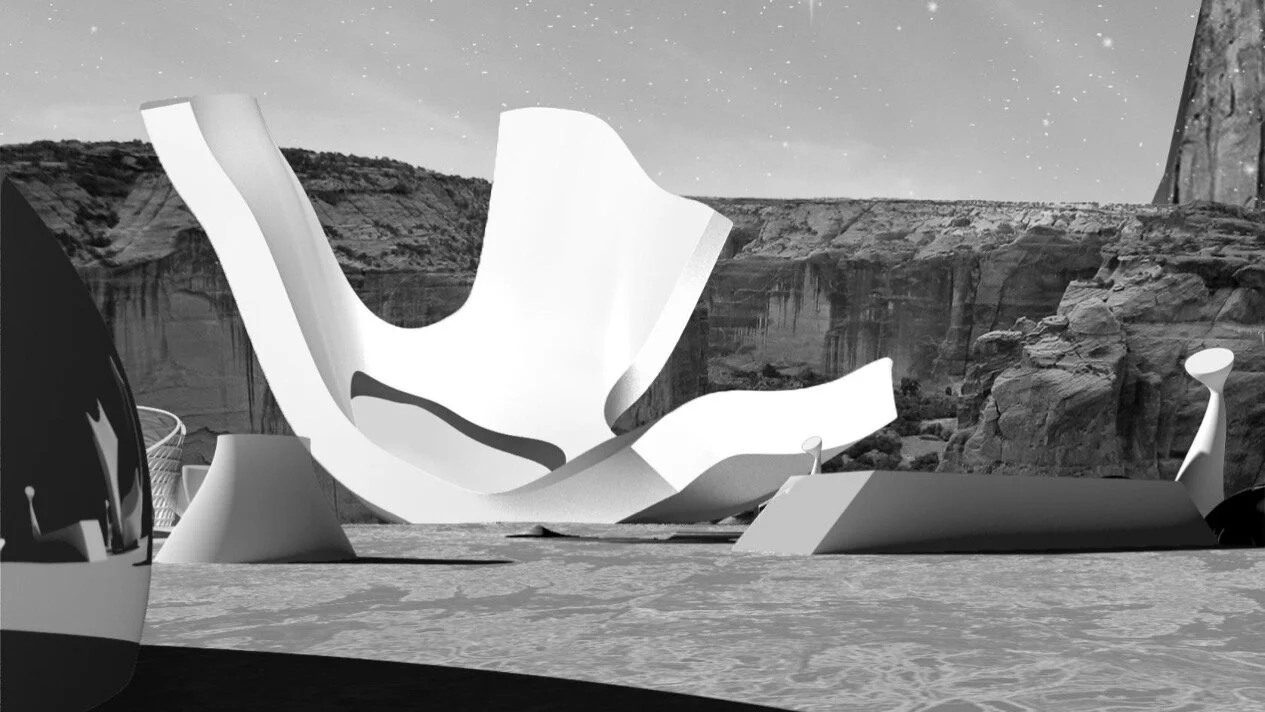
Cenotaph for Niels Bohr
The Cenotaph for Niels Bohr builds on the tradition of previous cenotaph's for Isaac Newton by Jean Étienne-Louis Boullée (1784) and for Albert Einstein by Lebbeus Woods (2009). As cenotaphs, these are not memorials, but dedicatory objects that aspire to give conceptual form to larger ideas embodied in part by the people they enshrine. If Boullée’s cenotaph for Newton embodied the ideals of Enlightenment classicism, and Woods' Einstein cenotaph meditated on the mysteries of the speed of light, our cenotaph for Bohr enshrines the uncertainty/probability/indeterminacy that is at the heart of quantum mechanics as one of the founding 'mysteries' of life. OUR Cenotaph for Niels Bohr situates the mystery of Bohr’s probabilistic universe, and its highly unlikely and fragile gift of life on earth, in an onto-epistemic dialogue.
The project has three components: The first consists of a [1/n:space] a Satellite orbiting one of the outer planets, preferably Saturn and [1/n: earth] a Receiving Station. The second consists of the Neutrino Detection Chamber and a corresponding plaque on the floor of the Indian Ocean. The third is the platform/mandapa which contains the housing for the scientists, extra listening equipment (real of fictional), and performance spaces.
The Orbiting Satellite has three missions:
1. OBSERVE THE ENTANGLED PARTICLES (does not transmit to earth since that would be impossible).
2. MEASURES LIGHT WAVES/PARTICLES (reports to earth will be “Wave - Particle - Wave - Particle - Wave...ad infinitum)
3. PHOTOGRAPHS EARTH TO CONFIRM ‘IT’S STILL THERE’ (reports to earth will be “Yes -Yes -Yes - Yes -Yes - Yes...ad infinitum)
In other words this satellite is not a typical ‘science’ project, but a philosophy project. At its rudimentary, it confirms that we exist. Should any of the message not repeat then…. Well we would not be here any way to receive them.
The Receiving Station functions both as a Scientific Laboratory and as a Ceremonial Temple.
The Laboratory holds the other part of the quantum entangled particle and it receives data from the satellite. Far below the surface of the earth there is a neutrino detection chamber. (For the future, the Laboratory is also set up to be the home of a particle collider.)
The Ceremonial Temple is a place where the mysteries/rationalities of quantum physics can be celebrated. According to the particle physicist cum queer feminist theorist Karen Barad, the Bohrian interpretation of quantum mechanics establishes a constitutive entanglement between matter and meaning, which is to say between being and consciousness or ontology and epistemology. Knowing in this sense is a constitutive property of matter, in as much as being of matter, or mattering, is fundamental to the nature of knowing. Extrapolating from this, quantum indeterminacy - or the matter-meaning entanglement - is the 'mystery' at the heart of everything that exists in the universe, including, the evolutionary phenomenon of life on earth. Tethered as such to quantum indeterminacy, life on earth is both extremely precious and extremely, extremely fragile, a fact underscored by the photograph of planet earth taken by the voyager aircraft in 1990 (repeated by Cassini in 2013) celebrated by Carl Sagan in his famous 1994 'pale blue dot' speech.
While dispelling the chimera of transcendental metaphysics of all types, the advances made by quantum physicists and other pure scientists offer the fieldwork for imagining a new quantum "metaphysics" of the present that engages with and ritualizes these scientific understandings of the abiding mysteries of the nature of the universe and of life emplaced in it.
The Receiving Station is located at the tip of one of the spurs of Canyon the Chelley, a site that that morphologically iterates the location of the Milky Way in Lanikeia (the galaxy supercluster that is home to the Milky Way). It presents itself as a set of Listening Ears, functioning communication antennas oriented to the Satellite and various other parts of deep space. These Listening Ears are sectionally connected to a set of subterranean chambers, that are the laboratories and analytic spaces.
The Buddha's ear and his hand-touching-earth gesture ("bhumisparsh", literally "earth as witness") provide the conceptual scaffold for this section.
The Listening Ears sit in the middle of a vast conical platform that is the social space, the 'Mandapa" in Sanskrit, of the Temple. This is the site that is designated for social ritual practices honoring and ceremonializing quantum indeterminacy and its constitutive entanglement with life on Earth (and most likely everywhere else). We imagine the Mandapa as the site of iterations of dances and rituals of the kinds celebrated on events such as solar festivals in native American ceremonies, stone circles of Europe, and temple dances of South India. Think Burning Man meets Quantum Physics.
The Neutrino Detection Chamber is located at a depth that is 'silent' enough to enable detection of the neutrinos. While neutrinos are bombarding the earth by the billions per square inch from every direction, they generally pass through without interacting with anything. The neutrinos that the chamber detects will have passed through the entire body of our planet. The chamber will also be used to detect dark matter. The Neutrino Detection Chamber is thus a ‘second ear” that is ‘listening’ for a particular form of cosmic interaction with the planet. The first ear, perched on the earth's surface is tectonic and acoustic; it is tuned into the steady and reassuring beat of ‘information’ from the satellite – indicating that the earth continues to exist and that quantum probability remains unchanged. The second ear, located deep in the body of earth, is chthonic and absorptive; it sits silently waiting for accidental collisions to take place within its detecting apparatus. The two 'ears' focus on different set of circumstances, but are both part of the same chain of quantum causality, as outlined by Bohr. The scientists and cultural priestesses 'offices' in the middle seek to ascertain and celebrate the links that connect them, for it is these linkages that, along the way, produce the human as a manifestation engendered by what we call 'evolution', which is itself a function of quantum probability. The ritual platform surrounding the surface ear, tilted at 2 degrees, is a site where we as humans can celebrate the experience of human manifestation along this chain of manifestations. To signify the 'girth' of planet earth, its figural bodiness, we will place a plaque at the antipodal point, which happens to be on the ocean floor off the coast of Madagascar.
The surface of this platform is 3% off horizontal. The reason is that if it were horizontal, then we are reiterating the metaphysical conventions of ‘ground plane/verticality of most religions. If the slope is noticeable then we would be emphasizing the corporeal anthropocentric place on the planet. We want to do neither. The 3% is imperceptible to the human body, but is enough to render the metaphysics of verticality conceptually impossible.
We have adopted the image of a particle coursing through the bubble chamber of CERN, as the starting 'plan' of the Ceremonial platform. This 'plan' we are hoping can be the basis of music and dances that are ritualistically tethered to the quantum-entangled particles, quantum indeterminacy, and the amazing fragility of life on Earth.
[1] Different from memorials, cenotaphs use the figure of the casket of a deceased individual to embody, to precipitate a larger idea. The person so-named is usually deeply and fundamentally connected with that idea, but the idea is not reduced to, defined solely by the life and interests of that person.
[2] Boullee’s cenotaph for Newton embodied European Enlightenment Classicism, the idea that the new epistemologies of deductive science and reason could be the basis of not just the laws of physics but of a new aesthetic and social order as well. This was humanism, the human animal at the center of a knowable universe, author of his own destiny. The possibility of attainable perfection, through cognitive knowledge, was embodied in this conception, embodied in the tomb by Boullee via //// An entire discourse of platonic and ideal forms and proportions, from the da Vinci’s drawing of the Vitruvian Man to Le Corbusier’s Modulor were indexed to this quest. Boullee’s cenotaph was intended to be located...where//?
[3] Entitled “The Vagrant Light of Stars”, Lebbeus Woods’ cenotaph for Einstein sought not to locate the object on planet Earth, but set it to travel from earth out into deep space, on a beam of light. This impossible to ever set sail object, for according to Einstein and according to the immutable laws of the universe nothing with any mass can ever travel at the speed of light, embodied the strangenesses of Einstein's relativistic universe by which gravity was the bending of space and time, and the equivalences of things like mass and energy were only one part of a universe in which about everything was interconnected, interchangeable, dependant. Everything, except light and black-holes that operated by and lorded over the rest of the laws of physics. The earth, with all its life, experienced itself at the center of its universe, with distant galaxies all hurtling away from it; but this was only an illusion; for every point in the universe experienced itself at the center of its own universe. So one universe, with every point in its center, was the quizzical description of a universe that placed us here on earth simultaneously at the center of the universe and, indeed, nowhere at all, lorded over by the immutable value of the speed of light. Set to sail on a beam of light, Woods cenotaph for Einstein was an impossible object, for nothing with any mass can, by Einstein’s rules, travel at the speed of light. It embodied the strangeness of the human experience on planet earth, placing us simultaneously at the center of our universe, and at the same time, nowhere at all. At the center of universe, the law of the speed of light would ensure that we could never traverse very far.
[4] Neils Bohr’s quantum descriptions of the sub-atomic universe, always at loggerhead with those of Albert Einstein, has introduced a world to us that is so bizarre that its implications for life, though at work everywhere and at all times, are still in some way, beyond human comprehension. Bohr’s probabilistic understanding of the universe offers a vision of the universe that is constitutively fuzzy, that throws up our human understanding of reality as nothing more than just that - an understanding. The theoretical phytsicist cum queer-feminist theorist Karen Barad describes Bohr’s quantum revolution as that of describign a constitutive entanglement between matter and meaning, being and thinking, ontology and epistemology. To be and to know are just two aspects of the same reality, according to the laws of physics; which means, particles ‘know’ and ‘feel’ things in a way that is linked to our way of knowing and feeling, and out being and facticity in the universe is identical to that of any other matter-knowing in the universe. Quantum mathematics can today accurately describe almost every observable particle and phenomenon, and it seems to conduct itself by properties that at least in some ways even defy the very precise descriptions of Einstein’s relativity - as for instance the ability of two entangled particles to ‘communicate’ across any distance ‘instantly’.
[5] Life on earth is very likely a consequence of the uncertainty or indeterminacy - the possibility of variation and random evolution - introduced into an otherwise immutable universe operating by constant laws. The very same uncertainty, however, also makes life on earth very fragile, extremely susceptible new uncertainties like a wayward meteor or human actuated climate change. This is the idea that was embodied by the photograph taken of earth by the Voyager spacecraft on 14th February 1990 (repeated by Cassini on July 19 2013) that was immortalized by Carl Sagan in his ‘pale blue dot’ narrative of earth:
“Our posturings, our imagined self-importance, the delusion that we have some privileged position in the Universe, are challenged by this point of pale light. Our planet is a lonely speck in the great enveloping cosmic dark. In our obscurity, in all this vastness, there is no hint that help will come from elsewhere to save us from ourselves….The Earth is the only world known so far to harbor life. There is nowhere else, at least in the near future, to which our species could migrate. Visit, yes. Settle, not yet. Like it or not, for the moment the Earth is where we make our stand."
It has been said that astronomy is a humbling and character-building experience. There is perhaps no better demonstration of the folly of human conceits than this distant image of our tiny world. To me, it underscores our responsibility to deal more kindly with one another, and to preserve and cherish the pale blue dot, the only home we've ever known.” Carl Sagan, Pale Blue Dot, 1994
[6] Bhumisparsha Mudra: Literally Bhumisparsha translates into 'touching the earth'. It is more commonly known as the 'earth witness' mudra. This mudra, formed with all five fingers of the right hand extended to touch the ground, symbolizes the Buddha's enlightenment under the bodhi tree, when he summoned the earth goddess, Sthavara, to bear witness to his attainment of enlightenment. The right hand, placed upon the right knee in earth-pressing mudra, and complemented by the left hand-which is held flat in the lap in the dhyana mudra of meditation, symbolizes the union of method and wisdom, samasara and nirvana, and also the realizations of the conventional and ultimate truths. Wikipedia







































![5. object in waiting axon [Converted]_final-01.jpg](https://images.squarespace-cdn.com/content/v1/5ed69c1f5084f43d41325967/1598024635234-IBOENM8K4J94NNKD7Q7V/5.+object+in+waiting+axon+%5BConverted%5D_final-01.jpg)











